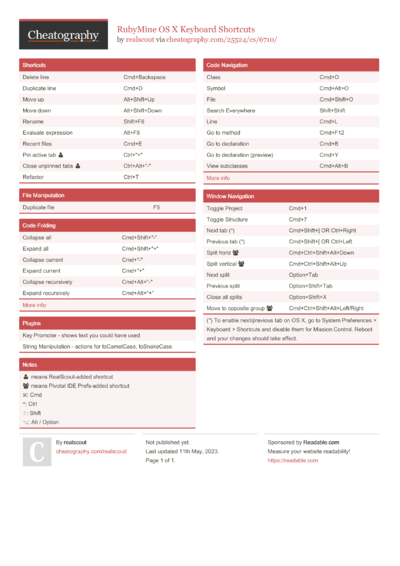

- #Rubymine keyboard shortcuts for mac
- #Rubymine keyboard shortcuts update
- #Rubymine keyboard shortcuts software
- #Rubymine keyboard shortcuts code

This is particularly useful for me whenever I want to just search. You’ll be able to select (or just plain type your own) a wildcard operator that returns all the file types of a certain kind. You can select the existing file type from the list, add a new file type, or add an additional file mask syntax to search for file types with certain patterns. Use the File Mask option to narrow your search to a specific file type. Search for specific file typesĪt the top of the find in files window is a feature called File Mask. To sort the search entries, select View Options | Sort Members Alphabetically in Show Options Menu (gear icon).įor more information on the options and icon references of the Find tool window, refer to the Find tool window reference section. To return back to the Find in Files dialog, click (gear icon) on the left toolbar. To locate the result of the search in the editor, use the Jump to Source option from the context menu.
#Rubymine keyboard shortcuts update
If you want to exclude a directory from the results, select a directory and from the context menu, select Exclude. In edit view, the form allows the user to toggle between project types for existing parent project records, and their appropriate children records: if the user update a project from a schedule projecttype to an event projecttype, a form to create events is presented, and children event records are persisted in the database as expected. To view this in Photoshop select Edit > Keyboard Shortcuts or use the. Using icons and context menu in the Find tool window, you can sort entries, exclude directories, navigate to the source code, and so on. What Is The Shortcut For Toggling Column Selection Mode In Rubymine For Os X. I was curious as to where all instances of clone() in the project, and I got this:Īccording to IntelliJ IDEA’s documentation: For example, if I click on a class to find its usage using Alt-F7 key combination then Gnome just grabs that window instead of passing it on to Rubymine. Here, I have the spring-boot project loaded up in IntelliJ IDEA. It seems like there are a lot of key combinations that Rubymine uses for which there are Gnome counterparts and therefore when I click the key combination, Gnome takes over. If you want to get an idea of what the functionality looks like when you’re trying to search something, here’s an example:

There, you can click to get into the actual functionality, and you’ll also be able to see a reminder of what the keyboard shortcut is. If you forgot the keyboard shortcut and don’t want to come back to this article, then you can simply navigate to IntelliJ IDEA’s Edit > Find > Find in Files… On Windows? Then you’ll want to hit these keys: ctrl + shift + fīasically, the only difference between the Mac and Windows way is swapping command and ctrl. Using a Mac? Then simply press these keys on your keyboard: command + shift + f Windows
#Rubymine keyboard shortcuts for mac
Well then, here it is, both for Mac and Windows: Mac You probably came to this article for one reason and one reason only: getting the sweet, sweet shortcut. To put it more concisely (and colloquially), it’s awesome.
#Rubymine keyboard shortcuts code
What that basically means is that if you’re looking for a particular word or keyword or string or substring or number in all of your project files, you can simply use the find in files feature built into the Integrated Development Environment (IDE) and then get a list of all files that match your input as well as where exactly in the code it occurs. This is one of the most useful keyboard shortcuts I can think of when it comes to working with IntelliJ IDEA: find in files. Refactoring Rename symbols, move members up/down. declaration from actual usage - all via simple keyboard shortcuts. Another helpful keyboard shortcut to improve your code is Alt + Enter that will automatically fix highlighted errors or warnings, then improve or optimize the selected code construct. Show intention actions and quick-fixes Alt + Enter. and compile code, to organize projects, or to test test them on various environments. This keyboard shortcut helps eliminate those and can be a lifesaver on long nights of coding.
#Rubymine keyboard shortcuts software
Top Software Keywords Show more Show less


 0 kommentar(er)
0 kommentar(er)
